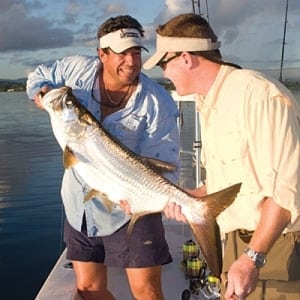Tarpon Fishing in Costa Rica: The Silver King of the Caribbean
Costa Rica is renowned for its diverse sportfishing opportunities, and while the Pacific coast gets much of the attention for marlin and sailfish, the Caribbean coast is home to one of the most iconic game fish in the world—the tarpon. Known as the “Silver King,” tarpon are powerful, acrobatic, and capable of testing even the most experienced angler’s skill and stamina. If you’re seeking explosive strikes, jaw-dropping leaps, and an unforgettable battle, tarpon fishing in Costa Rica offers a one-of-a-kind adventure.
Why Tarpon?
Tarpon (Megalops atlanticus) are legendary among anglers for their sheer strength, blistering runs, and aerial displays. It’s not unusual for a hooked tarpon to leap six feet out of the water in a battle that can last over an hour. These fish are notorious for shaking the hook, adding a level of difficulty that makes each successful catch a trophy in its own right.
In Costa Rica, tarpon regularly reach 100 to 150 pounds, and larger specimens are not uncommon. While they are bony and not typically eaten, their sporting value is immense, drawing fly fishermen and light tackle enthusiasts from all over the world.
Best Regions for Tarpon Fishing in Costa Rica
Tarpon are found almost exclusively along the Caribbean coast, where freshwater rivers and brackish estuaries meet the sea. This combination of habitats provides ideal conditions for tarpon feeding, staging, and spawning.
🎣 Barra del Colorado
Located in the northern Caribbean near the Nicaragua border, Barra del Colorado is widely considered Costa Rica’s tarpon capital. The convergence of the Colorado River with the Caribbean Sea creates a perfect tarpon environment. This remote area is best accessed by air or boat and offers high-volume tarpon action, especially during the peak season.
🎣 Tortuguero
Just south of Barra del Colorado, the Tortuguero canals and river mouths are another prime location for tarpon. The scenic backdrop of Tortuguero National Park, along with the calm backwaters and abundant bait, makes this area perfect for both sight fishing and trolling. It’s also an excellent destination for combining fishing with eco-tourism and wildlife watching.
🎣 Parismina and Pacuare Rivers
Smaller, less-pressured fisheries like Parismina and Pacuare offer quality tarpon fishing and are ideal for anglers looking for a more private or exploratory experience. The fishing may be slightly more seasonal or dependent on river conditions, but the rewards are well worth it.
Best Time of Year for Tarpon Fishing
While tarpon are present year-round, the most productive months are typically:
-
Peak Season: September through November
-
Secondary Season: March through May
During these windows, water conditions and bait migrations align, bringing large numbers of tarpon into accessible areas. Morning and late afternoon bites are usually strongest, and fishing around tide changes often increases success rates.
In the wet season, tarpon often move upriver, and as rivers swell, they gather in deeper channels and eddies. In the dry season, they’re often found in the coastal surf, river mouths, and estuary edges.
Techniques and Tackle
Tarpon fishing in Costa Rica demands both strategy and stamina. Whether you’re an experienced fly fisherman or a novice with spinning gear, here are some key methods:
-
Live Bait: Sardines, mullet, or mojarra fished under a float or free-lined near river mouths.
-
Artificial Lures: Soft plastics, swimbaits, and diving plugs that mimic baitfish.
-
Fly Fishing: Large streamers on 11- to 12-weight rods. Casts must be accurate and presentations subtle to trigger strikes.
-
Heavy Tackle: Medium-heavy rods with 50–80 lb braided line, strong circle hooks, and fluorocarbon leaders to withstand abrasive gill plates.
Once hooked, prepare for long runs, high jumps, and headshakes. Keeping pressure on the fish and bowing to the king (lowering the rod when it jumps) is essential to avoid throwing the hook.
Conservation and Catch-and-Release
Costa Rica promotes sustainable fishing practices, and tarpon are strictly catch-and-release to help preserve the species and the local economy it supports. Anglers are encouraged to use:
-
Barbless or circle hooks
-
Proper handling techniques (keep fish in the water)
-
Quick-release tools and dehookers
Many lodges and guides participate in scientific tagging programs to help researchers understand tarpon migration and population health.
Lodging, Guides, and Travel Tips
Most tarpon fishing trips on the Caribbean side include packages with remote jungle lodges, daily guided fishing, and meals included. Access is usually by small plane or boat from San José. Expect rustic charm, personalized service, and deep immersion in Costa Rica’s rainforest and river ecosystems.
Reputable guides are invaluable for navigating water conditions, tides, and seasonal movements. They also provide the necessary tackle and boats designed for shallow or river fishing.
Final Thoughts
Tarpon fishing in Costa Rica offers the perfect blend of challenge, beauty, and adrenaline. Whether you’re casting flies in a misty river at sunrise or wrestling a 100-pounder in the surf near a mangrove estuary, the experience is nothing short of magical.
The Caribbean coast may be less traveled than the Pacific, but for those in the know, it’s the realm of the Silver King—a wild, powerful fish that defines the spirit of sportfishing.
Book your trip, bring your strength and patience, and prepare for one of the most rewarding fishing battles in the world.

